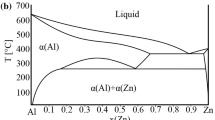Summary
Niocalite (monoclinicPa, a=10.863(3),b=10.431(3),c=7.370(2) Å, β=110.1(1)°) belongs to the cuspidine group. Its crystal structure has been refined toR 1=0.069 andR w=0.046, using 2411 independent reflections. Niocalite is isostructural with cuspidine and lavenite, but topologically distinct from the related mineral wöhlerite.
The present model differs, from the structure proposed byLi Te Yü et al. (1966) because of the different choice of space group (Pa instead ofP21). The previous erroneous space group identification was due to neglecting the usual twinning of niocalite. In fact, the X-ray diffraction patterns and the electron optical images show that the mineral occurs as a dense intergrowth of twinned lamellae, having (100) as the twin composition plane and 100–1000 Å thickness.
The chemical analysis, together with the results of the structure refinement, gives the crystal chemical formula Nb2Ca14(Si2O7)4O6F2.
The structure refinement seemed to indicate disordered distribution of niobium and calcium atoms within two different sites. In any case, this apparent disorder is supposed to be fictitious and would be due to the occurrence of twinning. Namely, the crystal structure would consist of twin related domains, each of them being characterized by ordered distribution of calcium and niobium atoms.
Zusammenfassung
Niocalit (monoklinPa, a=10,863(3),b=10,431(3),c=7,370(2) Å, β=110,1(1)°) gehört zur Cuspidin-Gruppe. Seine Kristallstruktur wurde verfeinert aufR 1=0.069 undR w=0,046, auf der Basis von 2411 unabhängigen Reflexen. Niocalit ist isotrukturell mit Cuspidin und Låvenit, aber topologisch verschieden von dem verwandten Mineral Wöhlerit.
Das vorgelegte Modell unterscheidet sich von der Struktur, dieLi Te Yu et al. (1966) vorgeschlagen haben, vor allem wegen der verschiedenen Wahl der Raumgruppe (Pa anstatt vonP21). Die Tatsache, daß die Raumgruppe früher nicht korrekt bestimmt werden konnte, geht darauf zurück, daß die verbreitete Verzwillingung von Niocalit nicht beachtet wurde. Diffraktometeraufnahmen und elektronenoptische Bilder zeigen, daß das Mineral als eine enge Verwachsung von verzwillingten Lamellen, mit (100) als Verwachsungsebene und 500–1000 Å Durchmesser auftritt.
Die chemische Analyse, zusammen mit den Ergebnissen der Strukturverfeinerung geben die kristallchemische Formel Nb2Ca14(Si2O7)4O6F2.
Die Strukturverfeinerung schien anzudeuten, daß eine ungeordnete Verteilung von Niobium- und Kalzium-Atomen innerhalb von zwei verschiedenen Positionen vorliegt. Diese scheinbare Unordnung ist nicht reell und ist dieser Verzwillingung zuzuschreiben. Die Kristallstruktur besteht aus zwillingsbezogenen Bereichen, jeder von ihnen wird durch eine geordnete Verteilung der Kalzium- und Niobium-Atome charakterisiert.
Similar content being viewed by others
References
Brown, I. E., Wu, K. K., 1976: Empirical parameters for calculating cation-oxygen bond valences. Acta Cryst.B 32, 1957–1959.
Hamilton, W. C., 1959: On the isotropic temperature factor equivalent to an anisotropic temperature factor. Acta Cryst.12, 609–610.
International Tables for X-Ray Crystallography, Vol. IV. 1974, (Ibers, J. A., Hamilton, W. C., eds.). Birmingham: Kynoch Press.
Kern, R., Rimsky, A., Monier, J. C., 1957: Contribution à l'étude de la niocalite. Comptes Rendus des Séances245, 2063–2064.
Li Te Yü, Simonov, V. I., Belov, N. V., 1966: Crystal structure of niocalite. Dokl. Akad. Nauk SSSR,167, 566–569.
Louisnathan, S. J., Smith, J. V., 1970: Crystal structure of tilleyite: refinement and coordination. Z. Krist.132, 288–305.
Megaw, H. D., 1968a: A simple theory of the off centre displacement of cations in octahedral environment. Acta Cryst.B 24, 149–153.
— 1968b: The thermal expansion of interatomic bonds, illustrated by experimental evidence from certain niobates. Acta Cryst.A, 24, 589–604.
Mellini, M., 1981: Refinement of the crystal structure of lavenite. Tschermaks Min. Petr. Mitt.28, 99–112.
—,Merlino, S., 1979: Refinement of the crystal structure of wöhlerite. Tschermaks Min. Petr. Mitt.26, 109–123.
Nickel, E. H., Rowland, J. F., Maxwell, J. A., 1958: The composition and crystallography of niocalite. Can. Min.6, 264–272.
Author information
Authors and Affiliations
Additional information
With 7 Figures
Rights and permissions
About this article
Cite this article
Mellini, M. Niocalite revised: Twinning and crystal structure. TMPM Tschermaks Petr. Mitt. 30, 249–266 (1982). https://doi.org/10.1007/BF01087171
Received:
Accepted:
Issue Date:
DOI: https://doi.org/10.1007/BF01087171




